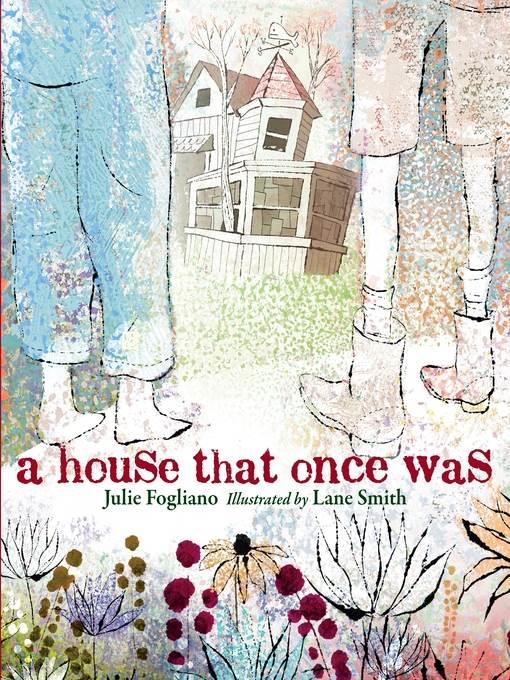
A House That Once Was
فرمت کتاب
ebook
تاریخ انتشار
2018
Lexile Score
500
Reading Level
0-2
ATOS
3.3
Interest Level
K-3(LG)
نویسنده
Lane Smithناشر
Roaring Brook Pressشابک
9781250315601
کتاب های مرتبط
- اطلاعات
- نقد و بررسی
- دیدگاه کاربران
نقد و بررسی

February 26, 2018
In this lyrical meditation by Fogliano (When’s My Birthday?), two children discover an empty, derelict house: “Deep in the woods/ is a house/ just a house/ that once was / but now isn’t/ a home.” Smith (Grandpa Green) draws the surrounding forest in bursts of texture and color, but when the children enter the house and wander through the rooms, the color fades and things take on a ghostly dimension. “Who was this someone who ate beans for dinner/ who sat by this fire/ who looked in this mirror?” Especially spooky are the photographic collage details showing the faces of the home’s long-ago residents. The moodiness lifts as the guessing grows silly, and Smith’s spreads switch to richer color, depth, and playful caricature: “Was it a man with a big beard and glasses who would look out the window and dream of the sea?” Sensitive readers may be put off by the story’s eerier suggestions (“Or what if they’re lost and they’re wandering lonely?”), while those who share a fascination with abandoned places will be entranced. Ages 3–6. Agent: Steven Malk, Writers House.

May 1, 2018
PreS-Gr 3-A wizard of wordplay and a maestro of composition combine their considerable talents to explore the notion of home. With a stylistic nod to e.e. cummings and just enough rhyme to propel the pace and please the ear, Fogliano tracks siblings as they approach and enter an abandoned house. Her lines about the dwelling are a study in contrasts. Once it was, but now it isn't a home. The boy and girl notice: "A door that is closed but not quite. A door that is stuck between coming and going. A door that was once painted white." As the children peruse books and objects, they extrapolate conclusions about the owners. Perhaps the man was a sea captain, the woman-a painter. Smith's complex, layered illustrations first depict an impressionistic forest world, rich with a bouquet of deep, dappled colors. (A note on process adds appreciation.) Lighter wildflowers grace the foreground, and a bluebird-a character to watch-transports a worm. Inside the house, it's as if the pages have been bleached; sunlight streaming through roof holes renders possessions transparent. Collage elements, such as a mouse poking through a portrait, add humor. As the imagined inhabitants assume center stage, the oil paintings take on more solidity and definition. While the final sentence reinforces the opening message, a concluding iris shot-with bluebird and babies singing merrily on branches that have invaded the structure-suggests an alternate narrative. VERDICT Stirring to the eye and the spirit, this evocative book repays frequent readings. Perfect for one-on-one sharing.-Wendy Lukehart, District of Columbia Public Library
Copyright 2018 School Library Journal, LLC Used with permission.

Starred review from March 15, 2018
A derelict house on top of a hill beckons two young children. Two children, possibly siblings, approach the waiting house on a winding, weed-covered path, all the while wondering about its past and those who dwelled within its walls. An empty window invites them to climb in. The tale is not told by the children but by an unseen narrator who seems to speak directly to the readers watching these events from outside the pages. The explorers find all sorts of items that were left behind, while the narrator asks, "Who looked in this mirror?" "Who napped in this chair?" "Who was this someone...who's gone but is still everywhere?" The language is direct, appealing equally to ear, eye, and mind. Intricate double-page spreads allow readers to follow the children as they explore and imagine and then return to their own cozy home. Smith's illustrations neatly separate action from imagination. The children and present-day house are depicted with blotted-line India ink, appearing a bit faded and mysterious (the children's skin takes on the color of the paper beneath). Their imagined house dwellers' activities are painted in bright, light-filled oils with paper collage; the soft edges of these reveal narrow white backgrounds, effectively separating them from now. It is all perfectly seamless; words and art are interwoven in a dance that enchants.Inventive and lovely. (Picture book. 5-9)
COPYRIGHT(2018) Kirkus Reviews, ALL RIGHTS RESERVED.

Starred review from April 15, 2018
Preschool-G *Starred Review* Deep in the woods is a house that once was but now isn't a home. Thus begins a beautifully written tale of two children, a girl and a boy, discovering an abandoned, boarded-up house at the end of a winding, overgrown path. The two climb inside and discover items the former inhabitants left behind, including a hand mirror, books, faded pictures, and an artist's palette that has them conjuring up possibilities as to who used to live in the house. Smith employs different techniques for his remarkable illustrations to show the two distinct sections of the story. When the children are exploring the building, the pictures have a mottled appearance with paint splatters and patterns gracing the backgrounds. When revealing the children's imaginings, the pages exude a calmer feel and use paper-collage textures that are almost palpable. Though the two children think they are alone in their explorations, their every movement is closely observed by a perky, inquisitive bluebird with a worm. Acclaimed author Fogliano (When's My Birthday?, 2017) offers up lyrical, free verse text that blends stunningly with Caldecott Honor Book illustrator Smith's (Grandpa Green, 2011) amazing illustrations to create a timeless feel and an outstanding picture book.(Reprinted with permission of Booklist, copyright 2018, American Library Association.)

























دیدگاه کاربران